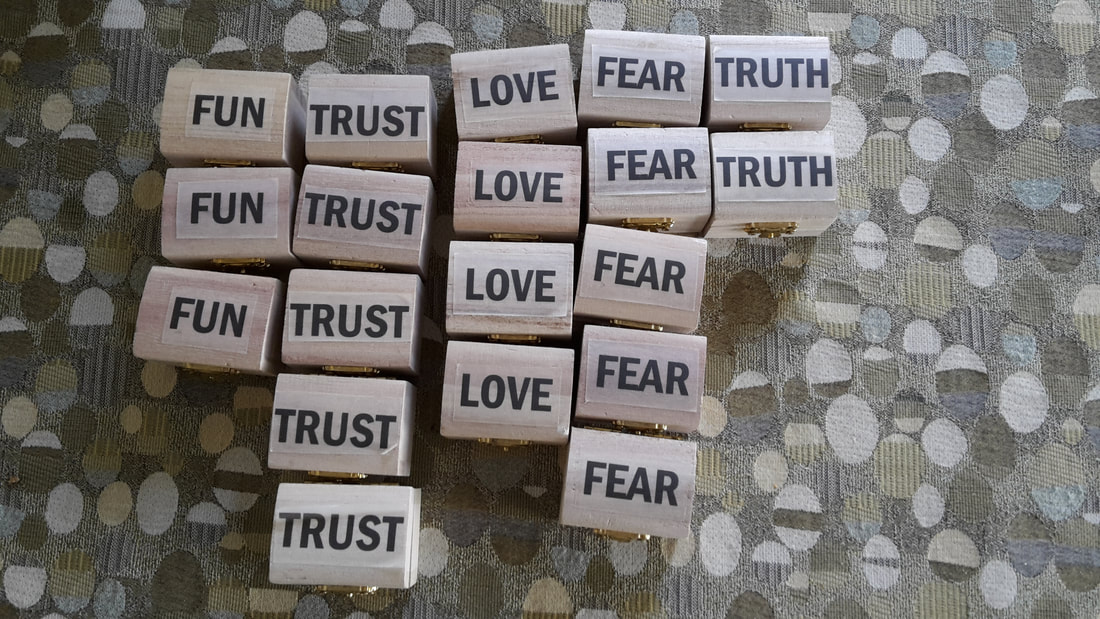 ‘How can I be more assertive?’ So many women bring this question to coaching sessions, as they explore ways to grow their leadership skills. Indeed, cultivating assertiveness is an important topic. Because whether it concerns sharing expertise, opinions or ambitions, many women find themseslves holding back from expressing what is on their mind in meetings or when speaking with more senior colleagues. While there may be different reasons for this reluctance to speak out, the consequences are pretty much the same. When we routinely give ourselves a free pass to avoid spotlighting our ideas and our opinions, we are unwittingly reinforcing outdated ideas about women in the workplace – namely doubts about our leadership abilities. So there is a lot at stake here, and I have become deeply curious about what is stopping highly qualified hard working women from showing up in ways that their presence and contributions are fully seen and heard. What are the main barriers and how can we overcome them? Being Pushy vs. Adding Value The word ‘assertiveness’ carries negative associations for many women, such as being pushy, domineering, or imposing ideas on others. So while there is an awareness that ‘assertiveness’ is something we need more of, these limiting beliefs demotivate us from practicing a more pro-active and self-confident way of communicating. To shift perspective, a simple and elegant way to reframe assertiveness is to think of it as ‘adding value’. In asserting your thoughts, ideas, opinions you are simply sharing what you are here to offer. The bottom line is that you got this job, have been promoted to this role or invited to this meeting for a reason: you are uniquely able to contribute something of value. Reminding ourselves that ‘we all need each other’ can melt the barriers that pop up when interacting with more senior stakeholders. Practice shifting your awareness from interacting with a ‘role’ and focus on the human being in front of you. Notice what happens when you honor your exchanges as mutually beneficial, in the service of working together towards achieving your common goals. Make it OK to be wrong Another obstacle to expressing our ideas and opinions is the paralyzing terror of being wrong or making a mistake, and then ‘looking stupid’. By asking ourselves some questions, we can start to deconstruct this limiting belief and weave together our own safety net to give ourselves permission to be wrong:
Getting comfortable with expressing our viewpoints in discussions, asking for what we need and sharing our vision and our ambitions, are core leadership skills for all genders. Focusing on the value you are adding and creating your own safety net to cope with making mistakes will help you to strengthen your ‘assertiveness muscle’. Cultivating assertiveness can challenge some of the core messages we recieved growing up about how women should behave. It can be tremendously liberating to let go of ideas that no longer serve us, while recognizing that behavior change takes time evolve. Remember to celebrate your successes! And know that by adopting a healthy approach to assertiveness, you are a positive role model for other women on the path to leadership. This article is part of a series highlighting one of the 8 areas of focus: ‘Communication Skills’, on the Female Leadership Wheel™ a unique coaching tool to support women in their leadership development. Check out my previous article : Emerging Female Leaders: Take Time to Map your Ambitions
0 Comments
 In my last blogpost I called on women to make a habit of broadcasting thier ambitions. Letting others know the future you are determined to create for yourself is the key to new opportunities. I am a strong believer in the saying, ‘Share your ambitions, and let your network do the rest.’ Start with Ambition-Setting While the returns of ambition-sharing are rewarding, let’s not overlook that it is preceded by ambition-setting. This is an exploration unto itself. It requires courage – to dream, to think big, to align with your values and to have an unshakable belief that you have every right to pursue whatever is meaningful to you. I recently posted a poll on LinkedIn asking emerging female leaders what put them most out of their comfort zone. Fifty percent of respondents replied that ‘mapping their career ambitions’ caused them the most discomfort. I began to wonder, what could be at the heart of a reluctance to create a plan for the future? Does it seem egotistical? Are wants, needs, aspirations too vague? Is there a belief that women cannot control opportunities to advance? Or is it just not a priority? Junk the egotism narrative! Let’s start by myth-busting the word ‘ambition’. For many women, this word conjurs up a masculine narrative of cut-throat opportunistic behaviors, ruthlessly exploiting others for personal gain. While this stereotype may exist, we need to call out the paralyzing assumption that it’s the only way to get to the top. It is this kind of thinking that conflates ‘ambition’ with ‘egotism’. And every time a woman holds herself back from creating a vision of her future for fear of being perceived as’ too ambitious’, ALL women lose. Because this is slowing down the trek towards gender parity among leadership in the workplace, miring talented women in the mud while their male counterparts navigate the uneven terrain in land rovers, tanked up with the energy of their ambitions. Going with the flow or charting your course? The analogy of driftwood vs. a wooden boat offers a more wholesome way to envision setting your career ambitions. On a body of water, driftwood moves in random directions at random speeds, without agency, subjugated to the external forces – currents, barriers (rocks and debris), weather etc. A wooden boat is steered; while it may change direction, navigate turbulent waters, stop at a harbor to resupply and to rest, its course is set by the captain – and that is you! Why should I do it? What is the value of a thoughtful exploration of your ambitions? As a resource your ‘ambition roadmap’ provides stability and guidance by helping you to:
Where do I start? You can start creating an ambition road map for at any time. It is an invitation to stop and ask yourself, ‘Where do I see myself in 1-2 years? 3-5 years? 10 years?’ You may already have a specific role in a specific company that you have set your sights on, or a revenue or expansion goal that you intend to reach with your own enterprise. But it is not necessary to instantly have these answers. What is important is identifying the impact you want to have, the kind of responsibilities that energize you, and what kind of environment you want to be working in. Choose any format that works for you: a narrative, a chart, spreadsheet, timeline, or a literal drawing of a map. This is not a predictor of your future but a personal resource to track your growth and progress in a chosen direction. While the direction may change, a roadmap drafted from ambition ensures that alignment with your values and needs remains solid. To kick-start this reflection process, here are some good questions you can ask yourself:
Choose for yourself! Bear in mind that this is about what you want, not what others want for you. Many women struggle with choosing for themselves when it comes to deciding what is really important to them. Remind yourself that you can add the greatest value to your organization, your field or your cause through the energy and commitment you bring to what you do. These powers are diminished when your choices are rooted in guilt, responsibility or loyalty to the wishes of others. Trust that your own values will be your best guide. Creating your own ambition map is an empowering process. It enables you to ‘steer your boat’ in the direction you want to go, adding reinforcements to the fleet of other women who have done the same, navigating to the higher ranks of leadership. You will sometimes need to jump in to the deep and take risks. There will be successes and failures along the way. But know that as you make progress towards realizing your career ambitions, your power, skills and experience will grow. This article is part of a series highlighting one of the 8 areas of focus: ‘Mapping My Ambitions’, on the Female Leadership Wheel™ a unique coaching tool to support women in their leadership development Check out my previous article : Why You Should Be Broadcasting Your Ambitions  Imagine that you want to hire someone to paint your picket fence. Jennifer has put flyers in your mailbox about her picket fence painting service and she even rang your doorbell once to introduce herself and talk to you about picket fence painting. You also know that Linda does something with painting, but you are not sure what is her painting specialty and if she would even be interested in painting your picket fence. Who do you reach out to first? Not a stretch to say most people would get in touch with Jennifer. While her selling efforts are obvious, what her initiative represents for the person with power to decide provides some useful insights for women eager to advance their careers. Because Jennifer:
So what are the potential gains of vocalizing your ambitions, that you may not yet have considered?
This article is part of a series highlighting one of the 8 areas of focus: ‘Mapping My Ambitions’, on the Female Leadership Wheel™ a unique coaching tool to support women in their leadership development Check out my previous article on Self-Care: 3 Easy Breaths and the ROI of Meditation  For the past year or so, at the start of every executive coaching session, I invite my coachee to join me in closing our eyes and taking three easy breaths. The purpose of this 15 second prelude to our conversation is to disconnect from whatever we were just doing before we joined the session, and to center ourselves in the here and now. If any of you are tempted to roll your eyes here, let me explain the simple logic. You cannot breathe in the past and you cannot breathe in the future. So simply shifting your focus to counting your breaths in real time is an easy point of entry to the present moment. What is astonishing is the difference these 15 seconds make. Often the coachee will spontaneously blurt out ‘Wow I needed that!’ ‘That was great.’ ‘That’s better’, ‘I should do this all the time.’ Sometimes I ask, ‘What is the difference for you?’ The response, from both women and men, inevitably includes words such as ‘calmer’ ‘more relaxed’ ‘better balance’ and ‘ready to start.’ If it only takes 15 seconds to get this result, can you imagine the impact of carving out a little more time on a daily basis for sitting quietly and focusing on your breathing? Yet what is commonly referred to as ‘meditation’ is curiously elusive for many career professionals. So let’s review the benefits of this untapped resource which offers a tangible difference in our performance and well-being. For starters, meditation costs nothing, doesn’t require any equipment, can be done almost anywhere at any time of day and doesn’t involve any special training. All you need is a place to sit where you won’t be disturbed, i.e. a closed door and a phone on ‘silent’. Connect with yourself before connecting with others The primary benefit of daily meditation is the framework it provides for engaging in your day through deliberate, conscious choices. This quiet ‘check-in’ with yourself at the start of your day, is an invitation to acknowledge what you are feeling and thinking about the day’s bundle of commitments and responsibilities. It also provides a reflective moment to connect the dots of what it all means for you in the bigger picture. The long-term benefits of regularly taking time for this inner ‘self-scan’ is like an insurance policy for our most constant companion, the one reflected back to us when we look in the mirror. As the comedian George Carlin remarked, ‘The only person who is with us our entire lives, is ourselves.’ This time spent on inward focus (anywhere from 5 to 30 minutes) gives us an edge of having first connected with ourselves, before stepping over the threshold to our workday, where we connect with others. This ‘edge’ translates to a stronger presence, clearer thinking, enhanced productivity and creative problem-solving – especially when the going gets tough. The alternative is functioning on automatic pilot. Going through the motions of what you believe you should be doing, because of what a dreaded future will look like if you don’t. You might enjoy some of your activities and even look forward to them. Regardless of whether you anticipate your day with anxiety or joy, meditation adds value by enabling you to prepare, reflect and choose an intention for how you will ‘show up’ on the day. Another built-in feature of meditation is agency. Choosing to withdraw from the demands of our environment for a specific timeframe every day reinforces our sense of autonomy. It’s an act of resistance to what often feels like relentless pressure to perform or get things done. It’s a reminder that no matter how much we feel beholden to the responsibilities of our jobs, our families and our communities, we are still the bosses of ourselves. Meditation Set-Up You can meditate sitting on a chair, or on a cushion on the floor. It’s important that your back is supported, so you might try adding a cushion or two against the back of the chair or the wall. If you are using a chair, make sure your feet are flat on the floor. Eliminate all distractions in the room by closing the door and setting all phone or computer messages to silent. If you are new to meditation start with 5 minutes. With time you might want to lengthen the session in 5-minute increments. After some years of experimentation, I have settled on a 20-minute session, and I use a timer. Remember, the length of the meditation session is not what matters, it’s the repetition (ideally) as a daily practice that makes a difference. Meditation Basics: Counting your breaths The red thread through the entire meditation session is counting your breaths (inhalation + exhalation) up to 10 and then starting over. When your mind starts to wander with other thoughts (which will inevitably happen) imagine those thoughts being encased in a bubble and floating away. Even if all you do is count your breaths, the meditation session will calm you down. The science behind this is simple and elegant. When you inhale you activate your bodies accelerator, the sympathetic nervous system. This is correlated with alertness and action, and in the extreme our fight-or-flight responses. Exhalation activates the parasympathetic nervous system, putting on the brakes, slowing down the heart and relaxing muscles. Balancing inhalation and exhalation are the keys to making sure your body’s accelerator and brake system are working harmoniously together. When we are stressed, this balance gets out of whack: it’s like driving your car with one foot giving full gas while the other is slamming on the brakes. Meditation relaxes the body by reducing stress hormones, cooling down you’re your metabolism. When things slow down, you are more aware of what is happening A Structured Meditation Session While there are many types of meditation that have evolved over centuries, I practice what I call a ‘Structured Meditation’. I follow a 7-step process, guiding me to consider certain questions or use visualizations to boost my readiness for the day. While I am sharing a format that I have discovered for myself, I invite you to customize the process – adapting the questions, shuffling the order of steps, etc. in any way that works for you. The key is to observe and accept whatever emerges, without judgment.
Why is this last step important? Because normally our conscious mind only has access to 10% of what is going on inside of us. The other 90% is in our unconscious, but nonetheless has a strong influence on how we perceive, behave and feel throughout the day. When we sit quietly with ourselves through meditation, the gates to the unconscious start to open, heightening our awareness about our own drives, needs and inner resources as well as our stumbling blocks. When you are ready to end your meditation session, either from an internal or external timer, just gently open your eyes, take a moment to reconnect with your surroundings - and voila! You are ready for your day. Conclusion Meditation practice is one of the most cost-effective and high ROI forms of self-care. Nonetheless, it remains undervalued as a resource for high performing professionals. To those remaining sceptics who believe that they just don’t have enough time or discipline for meditation practice, I leave you with a quote from Deepak Chopra M.D., a world renown researcher on the intersection of science and spirituality: ‘It isn’t successful habits that get (you) to the top. It’s being centered, aware and secure.’ While I have shared both meditation basics and a more detailed structure for a meditation session here, I invite you to start slowly with an open and curious mind. Even if it's just stopping what ever you are doing, closing your eyes and takeing three easy breaths, just pause and notice the difference.............. *For those who are interested in exploring chakra’s (the Indian tradition describing energy points in your body) and chanting as a support resource, there are several websites which provide information on this practice, for example https://evolutionvt.com/chanting-the-chakra/ This article is the second in a series highlighting one of the 8 areas of focus: Self-care Practice, on the Female Leadership Wheel™ a unique coaching tool I developed to help women identify areas for leadership growth. Check out my previous article on Negotiation Skills.  After a yearlong search and weeks of interviews at a rapidly growing consumer goods company, Emma was thrilled to learn that she was being offered a job. It was her dream role, leading a R & D team, in an organization whose culture and values reflected her own. Yet when the salary offer came in, her dream collapsed with a thud. Emma had done her research up front and knew that the company was offering 15% below market standard for her skill set. Convinced this was a non-starter, she declined the offer. HR came back with a simple question, ‘Can you be flexible?’ Emma’s response was just as simple: a firm and resolute ‘No’. End of story. The good news for Emma and all women, is that discussions about the gender pay gap have moved from the shadows to center-stage, creating a sense of urgency about addressing the issue. However, at the current pace of progress it’s going to take 40-60 years to close it. Emma’s refusal to accept anything less than an equal salary for a man with the same skill set is valid and understandable. In holding her ground for herself, she is holding the ground for all women, sending a clear message of resistance to unfair treatment and a call for change. But hold on a moment. Could there also be hazards to salary being the primary deal breaker for a job? There is no question that it is important for women to be paid fairly. But money is not the only factor that determines professional success. Instead of asking 'Is that all?' could we also ask 'What else is possible?' Should you find yourself in Emma’s situation, you might want to consider turning around and coming back to the table. Opening the door to negotiation can be a creative and collaborative undertaking while profiling you as a force to be contended with. Even if the job doesn’t materialize, you will have gained in other ways. Getting adept and comfortable with negotiating is an important leadership skill, vital for managing relationships and achieving goals, including financial goals, in the long term. So here are 3 reasons why it’s worthwhile to hang in there and negotiate:
Get comfortable with negotiating The reason so many women find negotiating stressful is because of perceiving it as a zero-sum game where there are winners and losers. A more wholesome approach is to view negotiation as a problem-solving exercise among equals. Instead of ’I need to get what I deserve.’, shift your mindset to ‘How can we make this work for all of us?’ Then get ready to unleash your negotiating skills. The principles are the same whether you are negotiating a job offer or a promotion. Here are some things to keep in mind.
Maintain the ‘We are negotiating as equals.’ mindset Introduce your topics one at a time and give yourself space to gauge the reaction of your negotiation partners. Are they getting energized, displaying a willingness to collaborate, thinking out loud to build on your suggestions? Or do they remain closed to any ideas and seem to just be running out the clock to end the meeting? No matter what, hang in there. This may not be the company you want to work with after all, but at least you are getting great practice at negotiation. Getting a sweet deal Do you sense a customized rewards package coming together? Keep going! Because you have reflected ahead of time on what is important to you, where you can be flexible and what is the minimum bundle of rewards you will accept to get you over the line, you can take it easy and be superbly confident that whatever outcome you get will be the right one. The freedom from attachment to the outcome is a boost to your negotiating power. A word of caution: never reveal your previous salary. Many companies use this information to try to convince you that you are getting better deal by offering an increase of 5%. Don’t take the bait! Be memorable Not being shy about negotiating and demonstrating a grasp of the process conveys self-belief and confidence in your value. Whether or not the negotiation process results in a deal, trust that you will leave a vivid impression in your wake. Don’t underestimate that something positive may come from this encounter sometime in the future. This article on ‘Negotiation skills’ is the first in a series highlighting one of the 8 areas of focus on the Female Leadership Wheel™ a unique coaching tool developed by Lisa Ross-Marcus to help women create their own plan for leadership development.  Having ‘authority’ is one of the many rewards of female leadership. Developing strategy, making decisions independently and expressing impactful opinions are all rooted in a sense that you know what you are doing, and you have the right to determine how things will be done. However, having more authority means that you could become a target for anger, grievances, and frustrations of those who depend on you to lead them. Sentiments expressed through insults, bullying and threats are all forms of aggression. While aggression can range from unpleasant to outright toxic, cultivating a resilient leadership presence means not wallowing in thoughts about how badly you were treated. Instead, keep your eyes on the road that leads to the outcome you want, while protecting yourself from getting dragged into a gully by the bad behavior of others. An unflappable response to diverse forms of verbal and emotional aggression is a leadership skill that will help you to keep your balance when the terrain gets rocky. Like many women, I was raised to avoid conflict. So, although it was rare, when confronted with anger or bullying, my usual cool would instantly vanish and I would wilt into a shaky, tongue-tied wimp, with no resources to push back on whatever insults or accusations were being hurled at me. In the aftermath I was often overcome with a feeling of shame about my total helplessness in standing up for myself. Over time I discovered some strategies for pivoting away from this depowering response. There are some very effective techniques for de-escalating combative interactions such as ‘Crucial Conversations’ by Patterson, Grenny et al. and ‘Non-Violent Communication’ developed by Marshal Rosenberg. Psychologist Liane Davey advocates for productive conflict in her book, ‘The Good Fight’. I would recommend checking out these frameworks for moving from anger and frustration to constructive dialogue. But to address the question ‘How can I empower myself when faced with aggression?’ I have discovered some mindset shifts which can be helpful before or during conversations, or anytime you are feeling stressed and insecure about your ability to manage a combative situation. Put on your imaginary bulletproof vest. Drawing on the body-mind connection, this simple practice provides a sensation of stability when you are feeling exposed and vulnerable. Just as law enforcement or journalists don this extra protection before entering dangerous situations, imagining that I am wearing a bulletproof vest has helped me to create my own safety bubble whenever I feel stressed or overwhelmed by antagonistic or undermining behavior of others. Besides literally changing my posture and gait, this physical sense of protection, especially around my heart, gives me an ability to take a step back from the drama and think clearly about the facts of the situation. When needed, my imaginary bulletproof vest helps me to be confident that I can handle adversity and choose my response in line with my own moral compass. Maintain control of your attention and energy. Besides face-to-face encounters, aggression also travels through digital channels such as email and text message, sometimes multiple times per day. While you cannot control the sender of the messages, it is you who is in charge of your attention and energy. This means you can decide when (and if) you will read messages, and when, how (and if) you will respond. While context, relationship and topic will influence how you handle cases of antagonistic behavior, here are some things to be mindful of when considering how to react:
Be in your best mood ever. When bracing yourself for a contentious conversation, it would seem counter intuitive to breeze in with your sunniest disposition. I was recently preparing for a meeting where high stakes outcomes were going to be decided. I knew from experience to expect personal attacks, undermining behavior, and an overall tense atmosphere. Up until 5 minutes before the meeting, my mood was somber, anxious, and insecure. And then suddenly I had a crazy thought: ‘I’m going to be in the best mood ever!’ And what happened? Those who were ready to attack seemed completely disarmed by my positive mood. And the atmosphere lightened up for everyone, as we swiftly addressed and resolved the issues of the day.I am not suggesting showing up at meetings with a ‘fake’ attitude of joy. This is about connecting with another part of yourself. In those last 5 minutes I shifted from my serious, worried and stressed side to the part of me that was proud that I had used my best thinking to prepare for the meeting, was happy to meet all of my colleagues again and was optimistic that we would reach a good outcome. Recognize that you have a choice. And see what happens when you show up in ‘your best mood ever.’ If any of these ideas for dealing with aggression resonate with you, I would love to hear about your experiences of trying them out!  A few years ago, I coached Carolyn, the Head of Global Campaign coordination for a small NGO. She had previously worked for a large non-profit organization, where she had developed a a wealth of expertise and leadership experience, fueled by her deep passion to make a difference. Carolyn was extremely unhappy; not only because her current job did not leverage her talents and provide any opportunity for growth, but also because the demands of work and travel far exceeded the assurances she had been given when she was hired. As the mother of two young children, the long hours and extended trips away from home were having a detrimental effect on her family life. Carolyn knew she had to make a change, but she was deeply insecure about her abilities to get another job. Her biggest desire was to find out what would make her happy and enable her to use her strengths and talents in a positive way. While every job has its down sides, I was struck by how out of balance the tradeoffs seemed to be in Carolyn’s case. She was getting too little of what was important to her and too much of what was draining and uninteresting. It made sense that she wanted to re-asses her values, and talents, in order to determine what kind of professional role would be rewarding now. Yet I was also curious to better understand what drove her to make the compromises she did in the first place. She complained often that her boss promised her things and didn’t come through, while at the same time he kept asking more and more of her time and energy. I sensed that the ‘Pleaser’ side of her was taking charge, preventing her from setting boundaries while boosting unrealistic high expectations of herself. With Carolyn’s permission, I interviewed the ‘Pleaser’ through Voice Dialogue. What we discovered was that the Pleaser’s behavior was often driven by a need to prove herself to others. By holding the bar high, so as make others happy, she repeatedly over-extended herself. She felt more comfortable making excuses for others and taking on their tasks herself instead of setting boundaries of responsibility. It became clear that Carolyn needed to connect with other parts of herself in order to practice assertiveness and direct communication. Her breakthrough came with the insight that if she was going to create more balance in her life at any job, she needed to learn to hold others accountable. After addressing Carolyn’s issues with boundary setting, we shifted the focus back to her goal of creating a vision for a job that would make her happy. In response to a series of questions on the topic of 'Who am I?’ and 'Ideal job description’, Carolyn was able to reflect on her priorities and desires in a way that helped to shape a new direction for her career. Carolyn was surprised at how easy it was to get immediate agreement from her boss once she clearly expressed her needs. She succeeded to extend her family vacation and cancel a non-essential business trip. When she informed her boss that the work load was too much, he immediately responded with an offer to raise money to hire an assistant for her. Carolyn called it her 'standing-up-for-myself muscle' and she enjoyed flexing it. Her newfound self-empowerment gave her the courage to turn down a new job offer which was below her level. Although she was determined to leave her present job, she now had the confidence and patience to wait until the right opportunity came along. Ultimately Carolyn decided to take the step to establish her own consulting firm to support other NGO’s. In her own words: I am living this dream now and it is making me super happy!  When she was four years old, Christa Kloosman saw ''The Nutcracker''and was totally enchanted. She started taking ballet lessons as a young child and continued throughout her school years, studying dance during the afternoons and on weekends. When she was 16, she was accepted at the dance academy in Tilburg where she was fast tracked to advanced classes and was a guest student at a Belgian ballet company. Christa later trained in Austria before being offered a contract at the Dutch National Opera. It was during her mid-twenties that Christa got a series of injuries which kept her away from performing and taking class for months at a time. She soldiered on despite the pain, telling herself "It's better than yesterday.", but more injuries followed. At a certain point, Christa knew she needed to find another perspective, so she decided to step back from the stage and the whole performing arts world. Her goal was to take a break, relax and get healthy again. She decided to enroll in a stewardess training program at KLM. I interviewed Christa in 2013 when she was just starting out as a pilot. To celebrate her being honored as a unique ''Nederlander'' I wanted to share her thoughts and observations again about her experience of being a dancer transitioning to a new career. You entered a program to become a stewardess but ended up as a pilot. How did that happen? I thought the KLM stewardess training program would give me some time to think about my situation. I had always liked traveling, so I would have the chance to finally see something of the world. The amazing thing is that the moment I entered the plane on my first day of training, I realized that I actually didn't want to turn to the right to the passenger section with the rest of my class, but that I would much rather make a left straight into the cockpit! I thought, 'Hey pilot! That's really something for me." And maybe I was a bit naïve - like many dancers - but I applied directly to the pilot academy - and I was accepted! What was it like to make the career switch from the dance world to the culture of airplanes and pilots? Actually, it was not as big a leap as you would think. In both environments I was surrounded by people who, like myself, were focused and passionate about achieving their goals, whether it was to be a star professional dancer or an excellent pilot. My experience of the two professions is pretty similar, except that I am not putting my leg so high in the air anymore. In what other ways is dancing like flying a plane? As in a dance performance, every flight is the result of the combined efforts of dedicated professionals behind the scenes. A dancer appears on stage knowing the steps and the choreographer who made them, the stage manager calling the cues and the conductor who leads the orchestra. She or he is supported by a team of dancer colleagues accomplished musicians. And without the technical guys who drive the whole production from one location to the next, the whole thing would never ''get off the ground." As a pilot you have to rehearse your tasks - the order, the timing and the interactions with your colleagues. You know your crew, and how they got trained. You rely on experts to check the plane and give it fuel. Air traffic controllers call the cues. The plane doesn't take off just because you are piloting it - there is a whole production team of people behind you who makes sure that the ''performance'' happens. What is it like to be a female pilot in a profession traditionally dominated by men? In my flight academy class of 20, there were only two women, myself included. Yet being a woman in this profession can be an advantage these days. KLM, like many other western airlines, is committed to hiring more female pilots. They have realized that female pilots create more balance in the cockpit, alongside male pilots. Women look at things differently, they are more creative and more precise in their work. So they are considered an asset to the flight industry. Which skills cultivated during your dance career helped you to become a pilot? When you are performing on stage and something goes wrong - with the lights, the music or the choreography- you have to make snap decisions and work with what you've got: your body, the choreography, your knowledge of the music, your awareness of who else is on stage with you, and the technical support off-stage. You improvise a solution by working with the material at hand and solve the problem so that things can continue. That is exactly what you need to do when you are having trouble in the cockpit: quick clear thinking and the ability to improvise. Although serious malfunctions while in flight are rare, if all of a sudden an engine stops, there is an explosion or a drop off - the same principle applies: you know yourself, the material and the capacities of the person sitting next to you and you have to think quickly and stay cool, just as you would when the unexpected happens in a dance performance. I also discovered that my short-term memory skills were highly developed from my dance training. While I found it challenging to absorb a lot of information out of text books, once I was in the cockpit - learning all kinds of codes for radar and operating information, I could immediately function on a very high level. This particular skill - used to pick up combinations in dance class for example - demands that you become a keen observer of details and process it all in a very short time. You repeat it a couple of times and then you've got it. In the cockpit I'm sitting next to the captain or my second officer behind me, and I’m also interacting with the cabin crew. I can pick up on important information because of a heightened sensitivity to how people use their bodies. I can quickly understand the strengths, weakness and styles of the colleagues I ''partner'' with. I multi-task by managing several channels of awareness at the same time. Certainly not all pilots have this skill. As an ex-dancer, what was the most challenging part of your pilot training? Because of my intense focus on dancing when I was in high school, I never learned science and math. I needed to quickly catch up in these areas. So I put in the extra study time and got a certificate in these subjects. Because I wasn't used to studying in this way, it took me more time to learn. In some ways I had to work harder than my colleagues. But I also proved to myself ''You are never too old to learn." Where there any qualities developed as a dancer that you had to overcome as a pilot? Yes, that was 'perfectionism' - that little voice inside that tells you that your leg isn't turned out enough, your dancing could always be more precise, you could be thinner than you are - anything I did could always be better. This attitude is a major weakness if you are a pilot. You must able to cope with things not going perfectly in order to pilot a plane safely. You need the ability to spread your focus on everything that is happening, because if you become obsessed with one detail, other things will fall apart. I learned this already from day one as a stewardess, which helped me to prepare for the flexibility I needed as a pilot. What would you advise other dancers in career transition? I would say, ''just be yourself" and don't ever underestimate what you have already achieved. There are so many skills you learn as a dancer that are transferrable to another profession. Focus on yourself and don't be concerned about what other people think of you. Take whatever support is offered. Seek contact with people outside the theater and artistic world as much as possible. Because the dance world can be so isolating, it's good, even temporarily, to have a little job outside the theater world. It doesn't matter what it is, the idea is to get a first experience in the "real world". Doing that small job isn't signifying the end of things - the stopping of dancing, but the beginning of a whole new world that is opening up for you. It's actually a great gift that you can start from scratch again. If you could choose one word, what would express your overall feeling about making a career switch? Freedom! As a dancer, you try to achieve that idea of flying onstage, defying gravity through physical power. When I am a stewardess or piloting in the cockpit, I am still flying, inspired by this sense of freedom for me. As much fun as I had as a dancer, I discovered that I could find a new passion, just as intense and rewarding through a different career, without the pain. That's such a gift. There is not one passion, but many passions in life. Lisa Ross-Marcus provides life coaching for dancers at all stages of their careers.  ''What do you feel passionate about?'' is a key question in any meaningful discussion about career choices. While those who have a clear sense of purpose are more likely to thrive in their professional roles, there is a distinction between those with high job satisfaction and those whose passion to create change and achieve the impossible is a zealous lifelong project. These are the individuals who stick their necks out, risk-takers who sacrifice security and ease while shouldering the responsibilities of making the world a better place. Think of mission driven roles such as NGO campaigners, political activists, and health care workers. And let's not forget civil rights lawyers and investigative journalists. What all of these outstanding professionals share is a passionate commitment to social justice and making a concrete difference in the well-being of people and planet. Whatever you do – don’t let others down Besides a sense that these professionals live and breathe their passion every day, they all tend to have something else in common: a deep conviction that they must not let others down. While this belief can inspire the qualities of tenacity, responsibility and self-belief, the shadow side of this mindset can drive some self-sabotaging behaviors such as micro-managing, inability to set boundaries and neglect of physical and emotional needs. Loyalty in the mission driven workplace. Based on shared values, the positive side of loyalty is that it binds people to a group, an organization or a cause. However, when loyalty becomes the primary standard for action, there is a constant potential to let someone down: Is it your manager who is pressuring you to stay up all night to finish a grant proposal? Your colleagues who don't want you to accept another job offer? Is it an invitation to another international conference? Or is it an entire village in Malawi waiting for you to lead a project that will require a long-term separation from your family? Numbing out our needs Of course there are times when rising to the occasion is the right thing to do, and the sense of achievement that follows boosts morale and maintains motivation. The problem occurs when the systematic fear of being disloyal - of letting others down- has a numbing effect on our ability to stay connected to our own needs. When these vital messages are blocked from the command control center in our heads, they find other ways to get our attention. We become irritable and argumentative. No matter how long we sleep we never feel rested. We seem to always feel harried and rushed; we make careless mistakes, and that queasy sensation in the pit of our stomachs is a constant reminder that we have already exceeded our limits. Yet these signals get routinely ignored, fueled by the belief that if others found out the truth, we would be letting them down. So the question is: How can we avoid the trap of depleting ourselves physically and emotionally, in order to remain loyal to the causes and goals we feel passionate about? The key word here is vulnerability. Your Personal Alarm system Feelings of vulnerability trigger the alarm system that lets us know when things have gone too far: when the gap between the demands being made on us and what we are capable of at this moment in time has gotten too wide. Allowing yourself to be vulnerable means recognizing the signals your emotions, your energy and your body are sending you. Be loyal to yourself Whereas loyalty refers to ideals, people and organizations outside of ourselves, vulnerability is a recognition of our inner needs and our ability to express them constructively to others. Being tuned in to your own vulnerability can be uncomfortable. It means letting go of the idea of always being strong, being able to cope and being in control. In a mission driven environment, your expression of personal needs could be perceived as undermining the plan, going off message or selfishness. Your loyalty to others may be called into question, and it is important to remember that this is not the issue. What matters here is loyalty to yourself - telling truth about what is really going on with you and trusting that your passion and commitment for what you do will continue to make a difference over time. The decision is yours: Are you going to burn your candle at both ends or be sustained by an eternal flame? Helping beliefs One principle used in coaching is to replace habitual limiting beliefs with fresh helping beliefs. Instead of thinking ‘’I am letting others down.”, you can also think “I am taking care of myself in order to keep my commitment to the cause I believe in.” Or “I can trust others to take on my responsibilities.” Or simply, “It’s OK for me to rest.” Focusing your attention on shifting what you believe about the situation you are in, will help you to stay positive and give you the courage to follow through on making other choices. Synergizing Loyalty and Well-being From a practical standpoint, there are several constructive ways to promote your own well-being while remaining loyal to your cause. Here are a few suggestions: 1. Don’t wait until the last minute: Whenever possible, don't wait until the last minute if you need to back out of a commitment. Show your support by giving stakeholders ample time to find a replacement or create a Plan B. 2. Support the new plan: Be willing to contribute help or expertise to the new plan, including coaching the person who will take over (some of) your responsibilities. This is not a moment to become protective or possessive of your own content or role. However, you can certainly request that you receive credit for your contribution to the endeavor. 3. No blame: Desist from blaming yourself or others for your need to pull back. You are not a victim, you are an empowered person asking for help and understanding with dignity. Your positive attitude will be a role model for others. 4. Troubleshoot: Learn to recognize colleagues and direct reports who might be suffering from a loyalty conflict. Show compassion and support for the idea of them looking after themselves and the value of their contribuion to the organization in the long term. Be catalyst of changing the culture in your organization from one which promotes ''loyalty at all costs'' to " support the well-being of our team." Lisa Ross-Marcus is a leadership coach for women and an intercultural consultant. I recently celebrated a milestone birthday which gathered together a diverse group of friends, colleagues and family, spanning several decades and careers. I found myself relishing the opportunity to stand in the spotlight and revisit the different roles I have had throughout my life, and witness how they have shaped the person I have become.
A brief slideshow shared my family history, followed by a film montage of my career as a dancer/choreographer. The submerged amaryllis centerpieces were masterminded by my inner weddingplanner, harkening back to the years when I martialed all of my theatrical experience to create unique and elegant wedding events. When it came to the party favors, it was the Lisa the Life Coach who took charge. I wanted my guests to leave with a playful yet meaningful souvenir of the party. Something that would trigger both personal reflection and lively dinner table conversation. Through my own research on the connection between text and emotion in a personal growth process, I had been experimenting with giving different word labels to boxes. I decided to roll this out in a concrete way for my party guests by creating a series of small boxes with 5 different texts. It was a simple project - I bought miniature wooden chests at a hobby shop ( 7.5 X 5.5 X 5 cm) and printed texts on transparent labels, which I then pressed onto the lids. I scattered these tiny text boxes on the tables and invited my guests choose the one that most resonated for them. They seemed both delighted and intrigued by the gesture. It was fascinating to speak with individual guests about which box they chose and why: LOVE: I'm going on a blind date next week and I'm hoping it will lead to something . FEAR: I have to take my school exams soon and I am afraid I won't pass. TRUST: I need to be reminded to trust myself. TRUTH: In these times we need to regain the meaning of that. I realised that the power of these tiny text boxes is not only in bringing into focus feelings which are 'top of mind' but also because they are miniature vaults for short written messages and very small objects. The strength of such an absurdly small box is that you can't really use it for storage. What ever goes into it is more likely to have a deliberate, symbolic meaning. In this sense, they are perfect ritual objects, which can be buried, burnt, cast into a body of water or cherished and displayed as reminders and vessels of ideas and experiences that are important to us. For this reason, tiny text boxes can be a useful tool in coaching. Clients who are visually and tactile oriented, who relate strongly to symbolism, are likely to respond positively to the introduction of a tiny text box as a support in their change process. For coaches, there are limitless possibilities of how to use the boxes. My guideline would be to empower the client to choose the text on the box, what goes in it and what happens to the box, in relation to making progress towards their coaching goal. This can be the starting point for a deeper exploration of specific issue or theme related to their change process. At the same time the tiny text box serves as visual anchor of a positive core idea or empowering belief that has emerged through the coaching, which will endure long after the coaching process is finished. If you decide to use the tiny text boxes as a coaching tool or for a personal use I would love to receive your to feedback, observations or questions. Thanks! |
AuthorAuthor: Lisa Ross-Marcus is a leadership coach and intercultural consultant. Her primary focus is empowering women to lead in organizations or as founders of their own enterprises. Archives
May 2024
Categories
All
|


 RSS Feed
RSS Feed